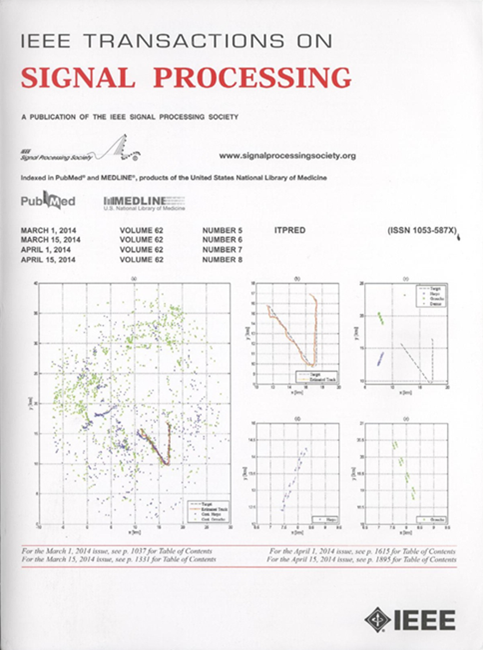基于资源节约型亚奈奎斯特阵列接收器的联合频谱传感和 DOA 估算
IF 4.6
2区 工程技术
Q1 ENGINEERING, ELECTRICAL & ELECTRONIC
引用次数: 0
摘要
随着无线通信需求的不断激增,频谱拥塞问题日益严重。结合频率和到达方向(DOA)估计的压缩频谱感知有助于实现超宽带场景下的高效频谱利用。为了降低硬件复杂度,本文提出了一种资源高效的阵列欠采样结构,该结构的特点是每个阵列单元只连接到调制宽带转换器(MWC)的一个支路,不同支路的调制信号具有相同的周期但不同的波形。该结构集成了阵列元素的空间采样和MWC的时间欠采样。针对所提出的采样结构建立了一个信号模型,该模型可以处理更一般的场景,包括多子带信号和跨带信号。提出了基于压缩感知和子空间分解的联合频谱感知算法。此外,设计了多分辨率网格优化策略,以低计算复杂度消除网格效应。我们还分析了结构参数对算法性能的影响,发现阵列元素的数量决定了子带内可以估计的最大信号数,而接收系统的等效信道总数决定了系统可以估计的最大信号数。分析表明,所提出的采样结构在结构参数选择和系统设计方面具有较大的灵活性。最后,仿真结果表明,在平均采样率相同或相近的情况下,所提出的结构和相应的方法可以获得更高的频谱和DOA估计精度。本文章由计算机程序翻译,如有差异,请以英文原文为准。
Joint Spectrum Sensing and DOA Estimation Based on a Resource-Efficient Sub-Nyquist Array Receiver
As the demand for wireless communication continues to surge, spectrum congestion becomes more severe. Compressive spectrum sensing with joint frequency and Direction Of Arrival (DOA) estimation is instrumental to enable efficient spectrum utilization in ultra-wideband scenarios. To reduce hardware complexity, this paper proposes a resource-efficient array undersampling structure which is distinctive in that each array element only connects to one branch of the Modulated Wideband Converter (MWC), and the modulated signals in different branches have identical periods but different waveforms. The proposed structure integrates spatial sampling by array elements and temporal undersampling by the MWC. A signal model is developed for the proposed sampling structure, which can deal with more general scenarios, involving multiple subband signals, and cross-band signals. Joint spectrum sensing algorithms are proposed based on compressed sensing and subspace decomposition. Additionally, multi-resolution grid optimization strategy is designed to eliminate grid effect with low computational complexity. We also analyze the impact of structural parameters on algorithm performance, which reveals that the number of array elements determines the maximum number of signals that can be estimated within a subband, while the equivalent total number of channels of the reception system determines the maximum number of signals that the system can estimate. Our analysis shows that the proposed sampling structure offers a greater flexibility in structural parameter selection and system design. Finally, simulations show that under the condition of the same or similar average sampling rate, the proposed structure and corresponding methods can achieve higher spectrum and DOA estimation accuracy.
求助全文
通过发布文献求助,成功后即可免费获取论文全文。
去求助
来源期刊

IEEE Transactions on Signal Processing
工程技术-工程:电子与电气
CiteScore
11.20
自引率
9.30%
发文量
310
审稿时长
3.0 months
期刊介绍:
The IEEE Transactions on Signal Processing covers novel theory, algorithms, performance analyses and applications of techniques for the processing, understanding, learning, retrieval, mining, and extraction of information from signals. The term “signal” includes, among others, audio, video, speech, image, communication, geophysical, sonar, radar, medical and musical signals. Examples of topics of interest include, but are not limited to, information processing and the theory and application of filtering, coding, transmitting, estimating, detecting, analyzing, recognizing, synthesizing, recording, and reproducing signals.
 求助内容:
求助内容: 应助结果提醒方式:
应助结果提醒方式:


